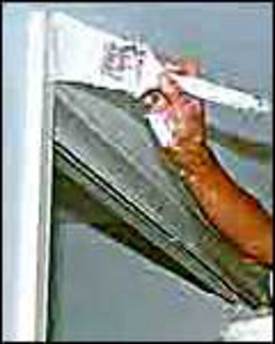All paints serve the same basic function, but what separates them are their durability, thickness, finish, hardness and drying time. Armed with a little knowledge of paint ingredients, you can comparison shop the professional and store brands with confidence. Oil-based is for woodwork; latex is for walls, so conventional wisdom goes. But there can be exceptions. Practical considerations factor into paint choice: room size, uses, light, children’s ages, foot traffic, condition of existing paint, and exposure to sunlight are all relevant.
 |
|
| Interior paint work takes time and attention to detail. | |
Matching the right paint to the surface will make a big difference in the longevity of your finished project. New drywall absorbs a coat of paint differently than does a pre-existing wall, as do brick, cinder block and concrete. Porosity (the size and number of tiny holes in the surface) affects how much paint is needed, so optimal coverage and the number of gallons required will vary depending on the surface. Taking the time to estimate how much you’ll need will save you time, money, and aggravation in the long run. Knowing your surface, measuring the area, and doing some simple calculations will give you the number of gallons needed for coverage. The resilience, bonding power, and sheen of various paints are also important. The look a paint will give you, how long it will last, the way it will reflect light and fend-off fingerprints are all dependent on these factors.
The Results Are up to You
Nothing guarantees the success of a paint job like good preparation. Resist the urge to grab the nearest brush or roller and start slapping on paint. There are walls to wash, cracks to fill, holes to patch, and painted woodwork to scrape![]() and sand. A good painter might also do a little detective work. Any damage to existing walls, wood or other surfaces needs to be followed up, not covered up. Find the underlying cause of cracked drywall, peeling paint or moisture. If your detective work turns up a problem, make the necessary repairs before applying the paint. Also, there’s technique involved. Like a smooth golf swing, rolling and brush strokes take some know-how. It’s not realistic to grip-n-rip and expect professional-looking results.
and sand. A good painter might also do a little detective work. Any damage to existing walls, wood or other surfaces needs to be followed up, not covered up. Find the underlying cause of cracked drywall, peeling paint or moisture. If your detective work turns up a problem, make the necessary repairs before applying the paint. Also, there’s technique involved. Like a smooth golf swing, rolling and brush strokes take some know-how. It’s not realistic to grip-n-rip and expect professional-looking results.
Lastly, in much the same way that walls, ceilings, and woodwork sparkle with a fresh coat of paint, they can actually seem bigger, brighter, warmer, more energetic or more intimate depending on your color selection. Let’s face it, there’s a reason why interior designers earn their fees: Knowing the secrets of color selection and color complements can save you those fees without forcing you to sacrifice the designer feel.
Wallpaper Brings Pattern, Texture, and Design
 |
||||
|
||||
Wallpaper is the second most common material for covering interior walls and surfaces. It introduces color, light, mood, and personality. Unlike paint, however, wallpaper hides the texture of the wall and imparts its own. Wallpaper also adds another dimension and pattern or design. Cork, grasscloth, and suede are some of the more exotic materials used in the making of wallpaper. Vinyl and polyester are more the norm, though.
Wallpaper needs to get to the wall with the least amount of hassle. Once it is hung, you’ll want your paper to stay there. Gravity and sticky wallpaper paste will conspire against you unless you take the time to prep the wall and prepare the paper. Check the condition of the walls, looking for weak or wet spots. Wallpaper glue bonds best to dry, clean surfaces. Make spot repairs as necessary; prepare walls, nooks, angled ceilings, skylights and flat ceilings. Above all, however, take the time to measure![]() . Wallpaper batches can differ slightly so don’t get caught short. Measure accurately and buy an extra roll or two with the same dye lot number.
. Wallpaper batches can differ slightly so don’t get caught short. Measure accurately and buy an extra roll or two with the same dye lot number.
Credit: Renovate Your World




























